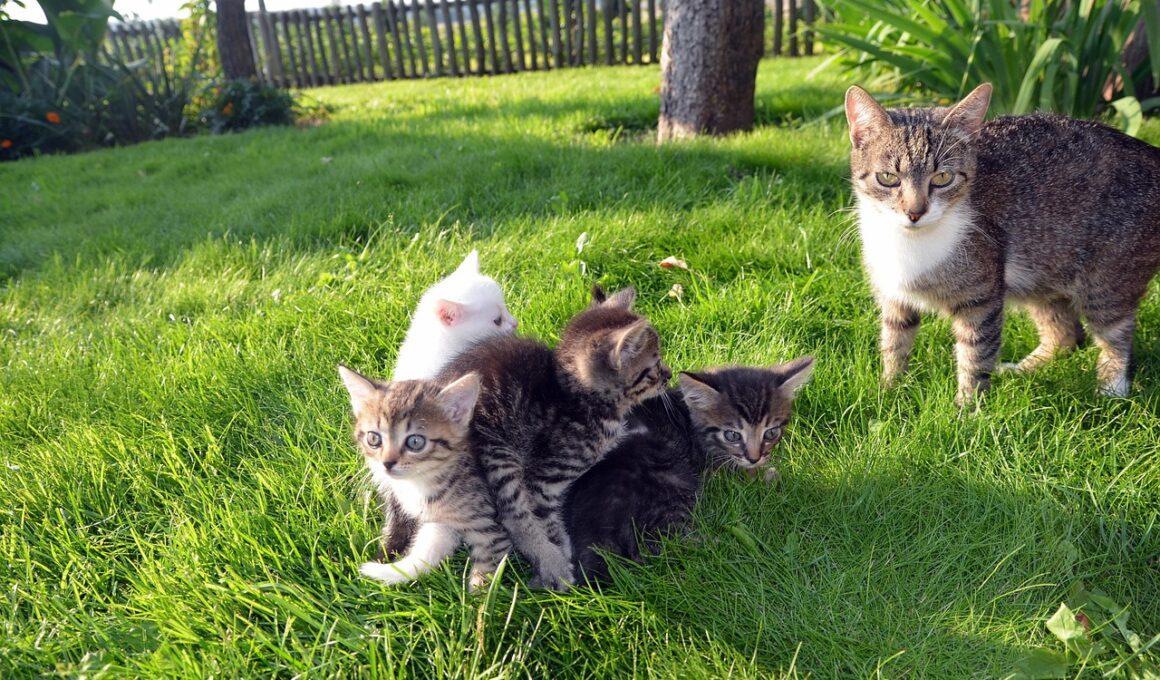Training Your Cat to Enjoy Safe Playdates and Friendships
Creating a safe and enjoyable playdate experience for your cat is essential. Just like humans, cats benefit significantly from positive social interactions. To initiate this process, start by choosing a well-known environment, as it will make your cat feel more secure. Introduce the new feline friend gradually by using a controlled environment and positive reinforcement. Always supervise their interactions, particularly during the initial meetings, to assess their comfort levels. Each cat has a unique personality; thus, it’s crucial to understand their behavior. This understanding means recognizing when a cat feels anxious or stressed. If either animal shows signs of discomfort such as hissing or growling, separate them immediately to avoid escalation. Setting up safe spaces, where each cat can retreat if needed, plays a significant role in their well-being. Consider using pheromone diffusers prior to the meeting to help ease any tension. Take advantage of interactive toys during playdates to promote engagement and enhance their experience. Continue to observe and conduct multiple sessions to ensure that both cats build a level of trust and friendship.
Establishing boundaries for playdates is essential in ensuring safety and enjoyment. As a cat owner, ensure that both pets have their designated areas where they can feel secure. This way, if they ever feel overwhelmed, they can retreat without fear. Encourage your cats to use those areas during the first interactions. A common suggestion is to start with short playtimes and gradually increase the duration as they adjust. Assess their body language during these encounters, looking for positive signs such as purring and relaxed postures. If you notice any negative signals, terminate the meeting early and try again later. Notably, providing a mix of playing options can help, including scratching posts and climbing structures to engage their instincts. It might be beneficial to incorporate interactive toys like feather wands or laser pointers. Always be patient during this process, as building friendships may take time. Incorporate treats to create positive associations when they are together, enhancing their bonding experience. Use short sessions for the best probability of success; spending too much time together could lead to over-stimulation. Ultimately, both cats will feel more secure and comfortable in such a controlled environment.
Understanding Cat Behavior During Social Interactions
Understanding cat behavior is crucial for facilitating successful social interactions. While they may appear indifferent at first glance, cats are sensitive animals that express emotions differently. Indeed, each cat has its unique communication style, so seeing signs of affection or discomfort is vital. Positive body language such as a slow blink or upright tail is a good indicator that a feline is feeling friendly. Conversely, if you notice flattened ears or a puffed tail, it’s a clear signal they’re feeling threatened. It’s essential to respect these signals and allow for personal space between interacting cats. Take time to observe how they react to each other’s playful advances. It’s natural for them to scent-mark one another during their interactions, which helps build familiarity and trust. If they’re playing together, be attentive to ensure that both are enjoying the game. Play aggression can often arise, leading to unintended harm if mismanaged. By introducing toys that promote healthy interactions, you can redirect their energy when things get too intense. The foundation for a happy friendship lies in recognizing and understanding these non-verbal cues.
When considering introducing a cat to a new playmate, ensure they are both healthy and vaccinated. A well-planned introduction involves ensuring that both cats are experienced with socialization. This is particularly important for younger cats that may not yet have learned proper social skills. Check with local shelters or breeders regarding their adoption policies, as many facilities prioritize social health education. Prior to any interaction, discuss with your veterinarian about safe playdates and potential age-appropriate activities. This helps ensure that both cats’ health needs are being met while respecting their limitations. When you have the green light, host small, manageable gatherings to gauge responses. It is crucial to ensure that both cats are familiar with their surroundings before introducing them to each other. Bring in additional elements, such as playtime with a trusted pet or familiar objects, into the meeting area to comfort them. In case you plan on introducing other pets, involve them in the process slowly. By gradually incorporating them into the playdate, you will create a less stressful environment conducive to positive experiences.
Choosing the Right Environment for Playdates
The environment where the playdate occurs is crucial in enhancing positive experiences. Select a safe, quiet space that’s free from distractions or any potential hazards. Exploratory cats may feel overwhelmed in new settings, so stick to familiar ones whenever possible. If this isn’t feasible, prepare the area beforehand with familiar scents, toys, and blankets to help them adjust. Check the space for potential escape routes or areas where they could get stuck. Conduct multiple pre-meets to determine how well they are adapting to the environment. Create engaging sensory experiences with interactive activities to encourage bonding. Plan for parallel playtimes where both cats can play in the same room without facing each other directly. This gradual exposure will help desensitize them and produce a more relaxed atmosphere. If they seem interested or curious about each other, allow brief interactions. However, do remain vigilant for potential issues such as territorial disputes. Redirection with toys can help prevent negative engagements. Patience is key as cats often need time to build confidence in unfamiliar situations and between one another, so take gradual steps towards successful playdates.
Facilitate safe playdates by making use of technology to monitor interactions. Setting up camera systems allows you to observe how your cats behave without being physically present, alleviating stress. Furthermore, you’ll be able to identify any recurring patterns in behavior unique to each cat, enhancing your understanding. If nervousness arises, try a break from the meeting and return once they have calmed down. During the process, it’s normal to encounter challenges, so remain flexible and remain open to trying different techniques. Keep in mind that socializing should always be a natural progression, rather than forced. Explore various playdates at pet-friendly cafes, training classes, or parks that permit safe feline interactions. It will prepare them for a range of environments. Also, it might expose them to different types of pet personalities. Remain diligent in observing their reactions if they react negatively in public places versus private ones. These experiences will contribute to their social development. Eventually, you will harvest the brain’s intrinsic ability to find companionship within safe playdates. Happy cats are social cats, and these gatherings can be the key to their emotional well-being.
Conclusion: Nurturing Lasting Relationships
Nurturing friendships between your cat and other felines can lead to remarkably fulfilling bonds. Cats are social creatures, and companionship can help reduce anxiety, creation of enrichment opportunities, as well as increasing their overall happiness. Prioritize positive introductions while keeping interactions structured and controlled. Remember that patience plays an invaluable role; some cats may take longer to build confidence than others. Regular, safe playdates can help solidify relationships while providing opportunities for your cats to thrive. By actively participating in their social experiences, you’re not only ensuring they remain safe but also laying the groundwork for lasting friendships. Always reward positive behavior with verbal praise or treats. Playtime rituals can further cement these relationships. Implement a consistently familiar routine around their interactions, making each playdate feel comfortable and enjoyable. Over time, their playful exchanges may transition into genuine friendships, providing not only joy but emotional support. Every cat deserves an opportunity to connect; hence, creating a safe environment helps facilitate those desires leading to mutual understanding. Celebrate each milestone of friendship, no matter how small, reinforcing the bonds between your cherished feline companions.
Your efforts in creating safe playdates can significantly impact your cat’s life. Through structured introductions and knowledgeable socialization tactics, your cat can learn to enjoy time spent with friends. Tailoring approaches to suit each cat’s personality is paramount. Recognizing behavior signals and knowing when to intervene or support them cannot be overstated. Continue gathering information from both professional advice and owners’ experiences. You might also consider joining online communities or forums dedicated explicitly to feline behavior. Here, you will find countless tips, tricks, and shared stories from those who have traveled similar paths. With a deeper understanding of your cat’s temperament, you’ll cultivate a supportive atmosphere conducive to happiness. Moreover, consider working closely with veterinarians and animal behaviorists. They can provide insight into socializing techniques that promote positive encounters. Don’t overlook the importance of regular playdates; as mentioned earlier, these gatherings not only foster connections but also influence well-being. Allow your cat to enjoy their space while fostering new relationships may require time and effort, but it will undoubtedly be rewarding. Adaptability and care will enhance both your life and your cat’s, nurturing these beautiful relationships.


